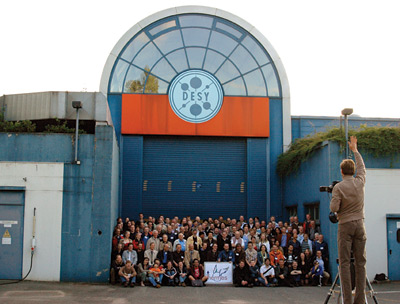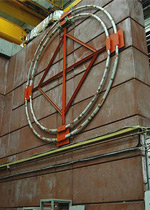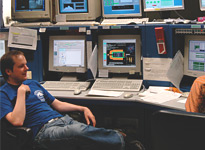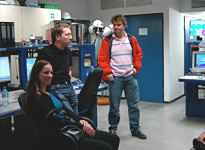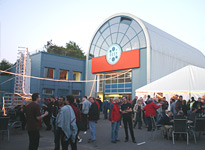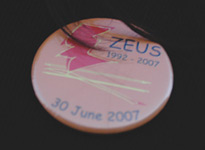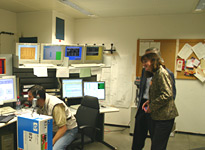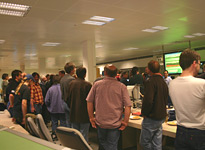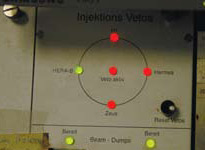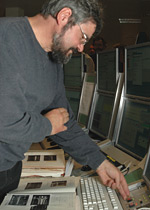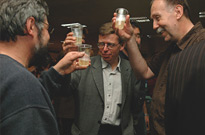The end of the HERA era
By David Harris
Celebration, anticipation, and a little wistful reflection: The final shift of the HERA accelerator brings more than 1000 people to Hamburg for a last hurrah.
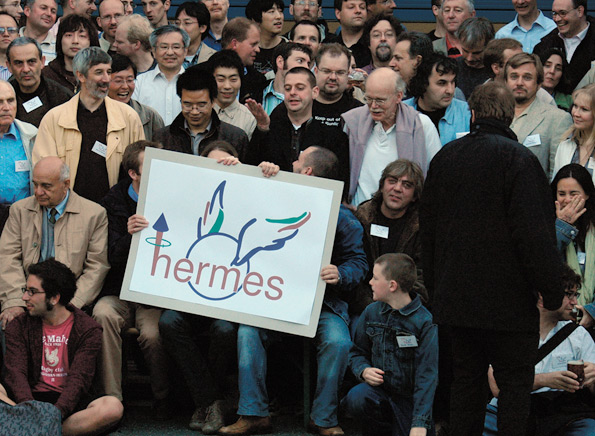 |
| Photos: David Harris and DESY |
| June 30, 2007, 8:00 p.m. | ||
|
Laughter punctuates the excited conversations, a mix of German and English. Drinks are passed around and children dart among the legs of the hundred or so scientists gathered together for one last time. The sky’s blue is deepening: only 90 minutes until sunset. A photographer tries to wrangle the merrymakers into formation while the light is still good. It is the final group photo of the HERMES collaboration, which is responsible for running one of the experiments on HERA, the Hadron-Electron Ring Accelerator, at the Deutsches Elektronen Synchrotron laboratory in Hamburg, Germany. Tonight, HERA and its experiments are to shut down after 15 years of collecting data. More than 1000 physicists and engineers have gathered at DESY to say goodbye. Each part of the facility is celebrating and commemorating in its own way, while collecting data until the last possible minute. The HERA beams must be turned off at 11 p.m. to ensure that they can power down before midnight and avoid paying surcharges to the electricity supplier for running into the next calendar month. HERA has already produced a remarkable suite of results that changed the way physicists think about the interiors of subatomic particles. HERA provided a detailed view of the proton and showed how the proton is much more than a simplistic collection of three quarks, two “up” and one “down.” The last shift is a time to reflect on these achievements, to talk about what is still to come from the data, and to enjoy the company of friends and colleagues, some of whom will not see each other again.
|
||
| 8:30 p.m.: HERMES | ||
|
Once the photographs are taken, Jim Stewart, the spokesperson for HERMES, reminisces about his 13 years on the experiment. “It’ll take a while to realize it is over,” Stewart says, obviously moved to see everybody gathered. “Some of these people I haven’t seen in ten years.” With the end imminent, many collaborators wanted as much time with their machine as possible. Stewart says people would come to the laboratory to work shift after shift in the control room during the last six months of running. Seven floors underground, in the HERMES control room, Pasquale Di Nezza, Vitaly Shutov, and Wolfgang Lorenzon work the last data-taking shift. “We’re very proud to be the last ones,” says Di Nezza. “We’ve all been here more than ten years.” In that time, the scientists have seen a lot happen, Shutov recalls: “A smart professor broke three interlocks and stopped the whole accelerator. Three times in a row in one shift!” With the end of the last shift less than two hours away, Shutov says that he will miss “friends, first of all and most of all.” For him, as for others who have worked a long time on the experiment, it’s more than just a job: “You are working, fighting, running, and finally you realize it is an essential part of your life.” Back above ground, Stewart is enjoying the party, but notes, “It’s a very weird feeling. Yesterday I was sad as the ending festival was going on. Today I’m getting used to the idea that the way I work will change.” He will stay at DESY to conduct more data analysis, dismantle the detector, and tend his on-site paprika crop, another sign of attachment to the lab and the experiment. Another experiment at the accelerator, HERA-B, closed down in 2003, but many of its collaborators have come back for this event. HERA-B was designed to look for a phenomenon called CP violation. In essence, it asked whether B mesons—particles that include a bottom quark—were the same as their antiparticles, apart from their opposite charge. HERA-B raced hard to try to beat two other experiments, BaBar at the Stanford Linear Accelerator Center and Belle at KEK in Japan, that were built as “B factories” to produce large numbers of B mesons. In the end, the B factories beat HERA-B to the discovery that CP violation does occur for these particles. However, the development work done at HERA-B helped create new types of detectors, including one that’s at the heart of an experiment at the Large Hadron Collider at CERN, the European particle physics lab near Geneva, Switzerland. In addition, HERA-B helped more than 100 students complete PhDs. Once the B factories began producing B mesons in large quantities, HERA-B turned to examining other particles, including charm quarks, and produced many competitive results, some of which are still being published. Michael Medinnis from the HERA-B collaboration joked earlier that their experiment was “the only HERA experiment not to discover the pentaquark,” a five-quark particle that seemed to have been spotted in various experiments around the world until later evidence effectively ruled it out. When HERA-B switched off on March 3, 2003, Bernhard Schmidt made the final entry in the logbook: “…in fact, at 6:45 the darkness was quite complete. And nobody around to say goodbye…Sleep well, old lady :-).” |
|
|
| The origins of HERA | ||
|
The concept of the HERA accelerator was born more than a decade before it took its first data. Around 1977, both CERN and DESY proposed electron-proton colliders to the European Committee on Future Accelerators. ECFA suggested that the two proposals be weighed against each other, and against international plans, before proceeding. A committee led by Chris Llewellyn-Smith and Bjørn Wiik recommended that CERN build an electron-positron collider. Following that, ECFA suggested DESY build an electron-proton collider. The formal proposal was developed in 1981. HERA used a novel financing arrangement for the time, asking that one-third of the required 600 million Deutschmarks in funding come from outside Germany. This initially met with skepticism. However, after some negotiations, the Italian national laboratory INFN committed 100 million Deutschmarks. Volker Soergel, formerly the director-general of DESY, said this was “a very forceful and shocking statement to the others. It made the plan to raise 200 million DM not so unrealistic.” Ferdinand Willeke, responsible for overseeing the HERA accelerators, said, “This was very successful, and has been called the HERA model ever since.” The project proceeded under Wiik’s leadership until the first collisions between protons and electrons were produced on October 19, 1991. HERA would later also run in a mode that collided protons with positrons. As with all accelerator projects, there were teething problems. This was DESY’s first experience with superconducting magnets, one of which failed during strenuous testing. Willeke commented that the incident was very useful in understanding magnet quenches, in which a magnet heats rapidly, and was, he joked, “an experiment our friends at CERN recently repeated with large success,” referring to a similar problem that occurred during magnet testing for the Large Hadron Collider earlier this year. However, once the accelerator and detectors were operating, results came immediately. The ZEUS experiment saw five events of a type called “deep inelastic scattering” on the very first day of running, May 31, 1992, and published their first paper on proton structure by September that year. |
 |
|
| 9:45 p.m.: H1 | ||
|
In contrast with HERMES, the last shift of the H1 experiment is quiet. The H1 end-of-run party is scheduled for a few days time. The parking lot is nearly empty and the setting sun seems symbolic. Four floors underground, the control room still has more than its complement of workers. Two people are assigned to the final shift, Mira Krämer and Tobias Zimmermann, but another four young postdocs hang around “for the fun of it,” as DESY’s Thomas Kluge says. “We were promised champagne, as well.” “I feel happy and also relaxed,” he says. “I like the atmosphere right now. It’s nice to gather together and store the last moments of beam.” H1 and ZEUS are the two large, general-purpose experiments at the accelerator. As Franz Eisele of DESY tells the story, about 25 names were suggested for the experiment, but none of them had majority support. Somebody in a cafeteria discussion suggested calling the experiments H1 and H2. The H1 collaboration accepted that arrangement, but the other collaboration didn’t like H2 and wound up calling itself ZEUS. Although the H1 collaboration reconsidered their name, nothing ended up replacing the cafeteria suggestion. The H1 detector was optimized for observing any previously unseen particles that might be produced, including the top quark, which remained undiscovered until Fermilab’s Tevatron found it at a higher energy than HERA could reach. H1 made much progress in understanding the structure of the proton; produced and studied particles containing bottom and charm quarks; helped test QCD, the theory of the strong force; and collected detailed measurements of particle reactions involving the electroweak force. Throughout its running time, H1 saw spectacular events containing possible new particles during the production of W bosons, but their meaning could not, in the end, be clarified and remains an enticing mystery. Eisele says, “These events were our biggest hope, and also our biggest disappointment.” |
|
|
| 10:15 p.m.: ZEUS | ||
|
To get to ZEUS, you drive into the parking lot of a racecourse and event center, park in the back and walk through the security gate to the distinctive above-ground hall that tops each of the HERA experiments. ZEUS physicists could watch events at the racetrack from the rooftop, just as HERMES physicists could watch football matches at the nearby stadium, at least until it was given a roof. But tonight, nobody cares about anything beyond the ZEUS grounds. The final-shift party is in full swing, and getting to the control room means wading through a congregation of excited, happy revelers. Down in the control room, Roberto Carlin is alone. His shiftmate, Paulo Bellin, has wandered off to check out the party, and Carlin is kept company by colleagues around the world who are hooked in by webcam. Physicists from Fermilab, Geneva, and London are watching from afar, being part of the last shift in their own way. Carlin is very happy. He says he is on shift by chance; the person who was supposed to be there didn’t show up in Hamburg. “There was a flood to sign up—I was the first to volunteer,” he says proudly. In the early days of ZEUS, the room was much more crowded. “The beginning was really tough,” Carlin says. Physicists had to spend so much time waiting for the beam to stabilize—often through the night—that they brought in a bed so they could catch some sleep. “We started with four on shift, and the control room was so crowded it was hard to find a place to stand,” he says. “Now it’s quiet and easy to run. But it was time to switch it off—it’s an old lady.” 10:30 p.m.: Upstairs, panic sets in. It seems that the red wine has run out and the partiers are not pleased. But Tobias Haas, incoming spokesperson for ZEUS, springs into action and finds the secret stash. He is dashing about keeping things running, helping set up the projection screen and loudspeakers for the slide show and later karaoke, pouring drinks, and ensuring everybody is having a good time. Haas’ role might seem a little strange: he is coming in as spokesperson even though the experiment has stopped collecting data. However, he is not concerned. “We will be quite busy for the next five years. My job will be to make sure all this data is analyzed. This is not so easy, as LHC is starting up and that is a strong attraction, especially for young people. However, I’m optimistic: we have data, while others are just promising data.” HERA results have shown their value in many ways. One is particularly important at this point in the development of particle physics. The LHC will observe a wealth of particles and collisions, and disentangling them will take a deep understanding of simpler and lower-energy processes. HERA data has allowed the prediction of many particle production rates and interaction strengths for processes that will occur in the LHC. This will help physicists interpret data, and also helps show them where to look in the first place. As in all long-running particle physics experiments, the legacy of HERA will further reveal itself over years to come. |
|
|
| 10:45 p.m.: HERA main control room | ||
|
As people start arriving at the main control room for the 11 p.m. shutdown, an announcement spreads that the final beam dump will happen at 11:30 p.m. The physicists are keen to squeeze every last piece of data out of the machine, and realize they can stop later than scheduled and still have time to power down safely. Mark Lomperski from the University of Washington is the head of shift in the control room. As the room fills, he says, “This is where one sees it really was a family that built this machine.” When Ferdinand Willeke enters and moves through the room, he is treated like a celebrity. On August 20, 1988, he had pushed the button to start up the accelerator. Now, nearly 19 years later, he will push it once more to stop the beams for the last time. 11 p.m. passes and a young Russian scientist, Yevgeny Negodin, takes over as shift leader. He is “really impressed” to unexpectedly take that role for the last few minutes. As the crowd mills about, they tell old stories, catching up with old friends. One physicist pulls out the early logbooks, and a few of his colleagues dig to find their first-ever logbook entries, from back when logbooks were still kept on paper. 11:05 p.m.: The number of people in the control room passes 100, according to a shout from the back of the room. The process of building an accelerator is long and complex, requiring much patience. Willeke reflects on his 25-year career in particle physics and the challenges along the way. “You just have to take a deep breath and say, ‘This is one step done,’ and the details begin and you do a lot of work over a large amount of time,” Willeke says. With HERA closing down, he says he hopes “the sacrifice will not be for nothing. I hope this will free some resources to go into the ILC,” or International Linear Collider. Willeke is already dreaming of building the ILC, but that is far in the future. In the meantime, he is leaving one week after HERA closes to work on an accelerator at Brookhaven National Laboratory, Long Island, New York. 11:15 p.m.: A 15-minute countdown is announced. Willeke pulls out more old logbooks and chats with Albrecht Wagner, director-general of DESY. People ready their cameras. 11:20 p.m.: The room is suddenly quieter. 11:25 p.m.: “We lost the positrons!” Shouts erupt around the room, followed by groans, and then laughter. Willeke jokes, “Something suspicious is happening in the south [part of the machine]. I hope somebody from ZEUS didn’t fall into the beam!” Fortunately the proton beam is still running. Michael Bieler, the technical coordinator for the shift, is on the phone asking the experiments to shut down their high-voltage power supplies, and trying to diagnose the reason for the lost beam. A countdown begins. 11:29:44 p.m.: Willeke pushes the button and applause breaks out. Wagner shakes hands with Willeke, offering his “greatest thanks.” 11:30:36 p.m.: The first champagne cork pops in the control room. One sentimental physicist goes to the terminal and sneaks a message onto the electronic notification system: “Thank you HERA. R.I.P.” |
|
|
| July 1, 12:05 a.m.: The ZEUS party | ||
|
Back at ZEUS, the party continues and collaboration members take elevators down into the cavern for a last photograph with their detector. Elisabetta Gallo, the spokesperson for ZEUS, points out the national groups saying one last goodbye to the sections of the detector they created. The Italian contingent has trouble cramming everybody into the muon system electronics room. The accelerator tunnel opens and people go to explore. During the evening they will say their goodbyes, with the keenest among them partying and dancing until dawn before heading into downtown Hamburg. But for now, Gallo looks wistfully across the cavern and says, “It’s very sad, but a bit happy.” |
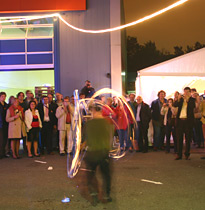 |
|
| HERA at a glance | ||
|
Location Data collection Experiments Tunnels Collision modes Construction partners Experimenters Energy Cost |
Click here to download the pdf version of this article.



